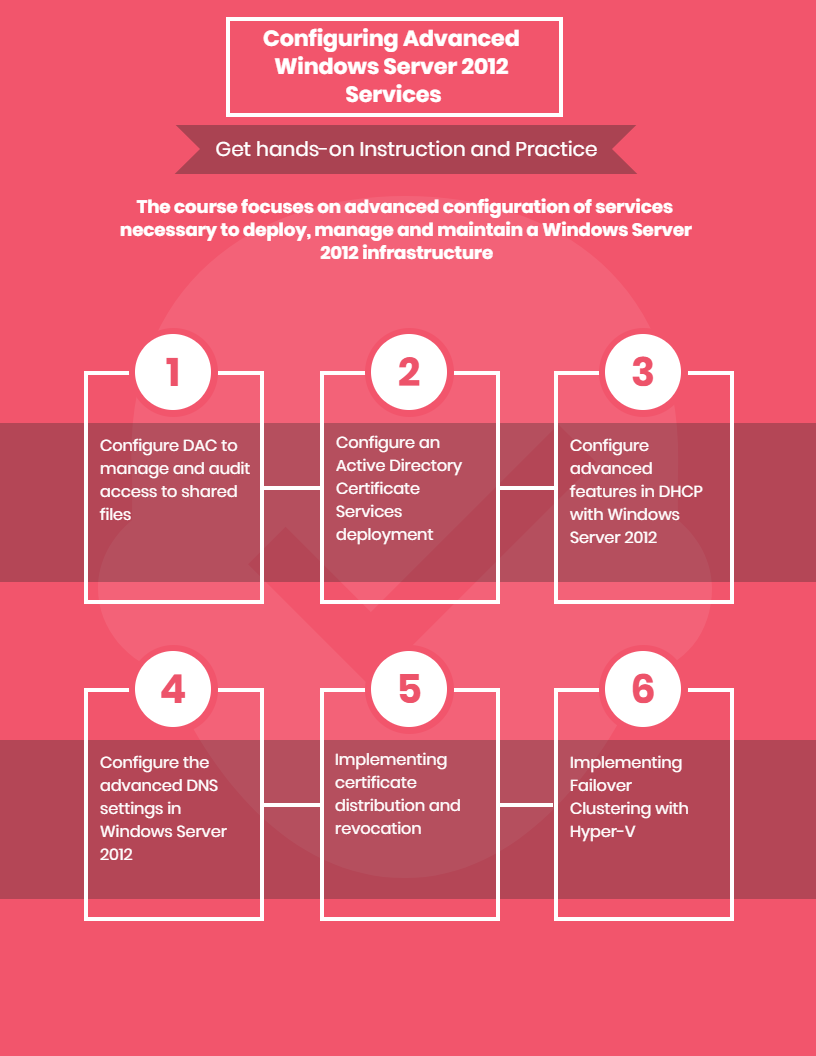Implement Advanced Network Services
- Configure Advanced DHCP Features
- Configuring Advanced DNS Settings
- Execute IP Address Management
- Maintain IP Address Spaces with IPAM
Implement Advanced File Services
- Configure and manage iSCSI Storage
- Implement BranchCache
- Configure Windows Server 2012 features that optimize storage utilization
Implement Dynamic Access Control
- Explain DAC
- Configure DAC Components
- Configure DAC for Access Control
- Describe Access Denied Assistance
- Implement Access Denied Assistance
- Configure and manage the integration of Work Folders with DAC
Implement Distributed Active Directory Domain Services Deployments
- Describe Distributed AD DS Deployments
- Configure a Distributed AD DS deployment
- Implement AD DS Trusts
Implement Active Directory Domain Services Sites and Replication
- Describe AD DS Replication
- Implement AD DS Sites to optimize AD DS network traffic
- Implement and Monitor AD DS Replication
Implement AD CS
- Explain and use Certificates in a Business Environment
- Describe the architecture and components of Public Key Infrastructure (PKI)
- Explain the options for implementing a certification authority infrastructure
- Design and Configure an AD CS certification authority infrastructure
- Configure and Manage Certificate Templates
- Implement Certificate Distribution and Revocation
- Implement and manage key Archival and Recovery
Implement Active Directory Rights Management Services
- Describe AD RMS
- Install and Manage an AD RMS Infrastructure
- Implement AD RMS Content Protection
- Implement External Access to AD RMS
Implement and Administer AD FS
- Explain the Identity Federation Business Scenario
- Describe AD FS
- Deploy AD FS Services
- Implement the AD FS prerequisites
- Configure AD FS for a Single Organization
- Implement AD FS in a Business-to-Business Federation Scenario
- Configure the Web Application Proxy
- Extend AD FS to External Clients
Implement Network Load Balancing
- Describe Network Load Balancing (NLB)
- Set up an NLB Cluster
- Planning an NLB Implementation
Implement Failover Clustering
- Overview of Failover Clustering
- Describe Features of Failover Clustering
- Deploy a Failover Cluster
- Configure Highly Available Applications and Services on a Failover Cluster
- Manage a Failover Cluster
- Configure a Multi-Site Failover Cluster
Implement Failover Clustering with Hyper-V
- Describe Integrating Hyper-V with Failover Clustering
- Configure Hyper-V Virtual Machines on Failover Clusters
- Explain and Implement a Hyper-V Virtual Machine Movement
- Describe a High-Level Overview of Microsoft System Center 2012- Virtual Machine Manager
Implement Business Continuity and Disaster Recovery
- Explain Data Protection
- Plan and Implement Windows Server Backup
- Implement Server and Data Recovery





